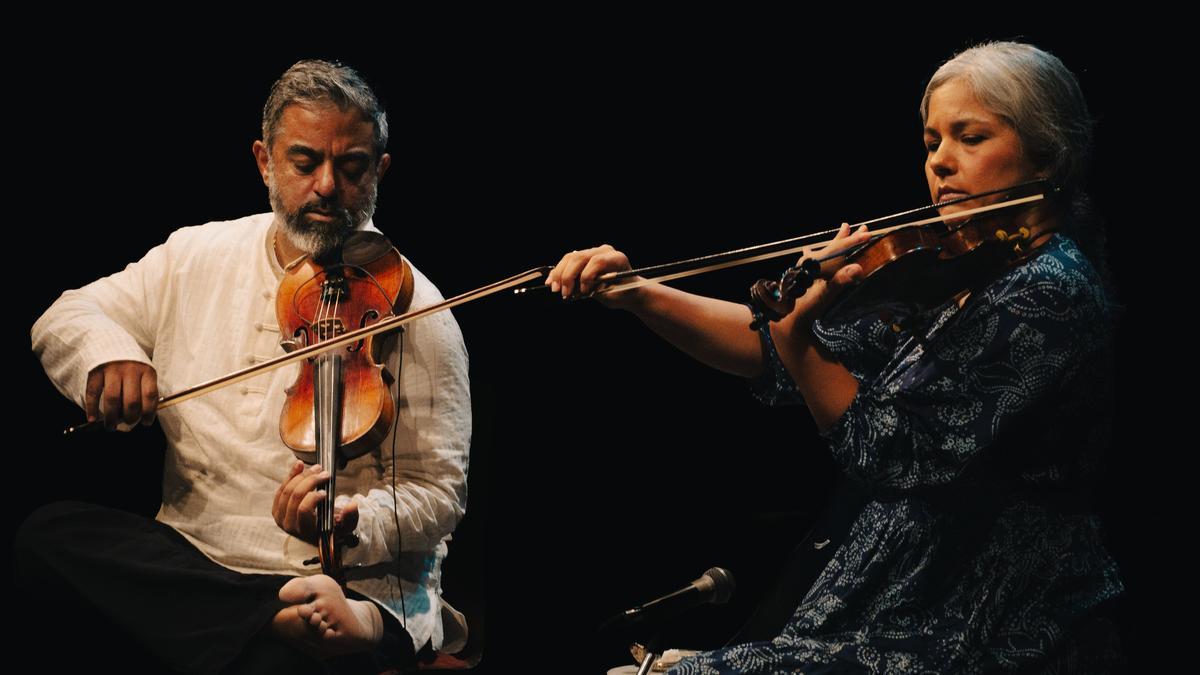
In an evocative performance at the Bangalore International Centre, the violin duo of Arun Ramamurthy and Trina Basu presented “Nakshatra,” a concert that seamlessly intertwined the rich musical traditions of the East and the West. The event was not just a confluence of cultures but a celebration that offered audiences a richly detailed, living canvas of music, expanding as large as one’s imagination could take it.
The duo, originally hailing from Brooklyn, New York, brought their music to Bengaluru as part of their maiden concert series in India. Touring the cities of Kolkata and Bengaluru, they shared compositions from their first album and other select pieces. Their music did more than just bridge cultures; it redefined the potential of music as a whole, especially pertinent to the discourse on the institutionalization of music education in India, akin to the Western model.
Opening the concert, Arun and Trina dedicated their first piece to Lenapehoking, also known as Prospect Park in New York. This area was home to indigenous people who lived in harmony with nature before the onset of colonization. Trina shared an emotional note about how Prospect Park had provided a refuge during the pandemic, with the only sounds being those of birds and ambulances. Set in the popular raga Abheri, the composition was infused with ecological and ethical themes that surfaced repeatedly throughout the concert.
The second piece, “Tempest,” carried the clarity and stillness that follows a storm. Utilizing ragas Gowri Manohari and Vachaspati, the composition provoked thoughts about how disparate musical elements can coalesce into a unified soundscape. “Migration,” played in the Mohanam raga, drew inspiration from the migratory journey both their families took from Bengaluru and Kolkata to the United States.
Nature’s inconsistency and its elemental beauty were central themes in the following pieces. Progressive notes in the raga Hemavati recreated the mesmerizing spirals of the Fibonacci sequence, while their harmonic rendition of “Sri Kamalambike” in Sree raga showcased how the notes SRMP and MPNS, when played together, could form a compounded musical treat. Their reinterpretation of this Muthuswami Dikshitar composition referenced the twentieth-century adaptation of the violin in Carnatic music by Baluswami Dikshitar, showing how a Western instrument could be embedded into Indian musical traditions.
. The duo elevated this historical adaptation to new heights.
Their subsequent arrangements and compositions were enriched by a blend of American folk, Carnatic, jazz, and film music, among other genres. Arun and Trina’s propensity for deep listening and creating space for each other’s expression imbued their performance with an array of musical colors and textures, opening the doors to myriad shades and possibilities.
Interestingly, the journey of their collaboration dates back to 2007 when Arun’s Carnatic music teacher, Mysore Manjunath, introduced them after Trina spent a year in India for musical training. Shortly thereafter, the two joined a local Carnatic ensemble named Akshara. Their shared musical chemistry led to years of practicing together, sharing stories, discussing musical ideas, and evolving their approaches to the violin. By 2012, they were composing and performing together as a duo. They aimed to create music “unapologetically from the heart,” striving to stretch creative possibilities and address real-world issues through their art.
For Trina, experimenting with various elements and techniques from different violin traditions—Indian raga/tala, Western chamber music, counterpoint, harmony, and fiddle/folk styles—offered a vast palette of colors for composition. Arun resonated with the concept of allowing their subconscious minds to take over during musical collaboration, thus making their music deeply meaningful both to themselves and their audiences.
Both musicians have independent careers but use their home as a multi-functional space for work, rehearsal, teaching, and family life. Arun acknowledges the challenges associated with partnership and parenting, yet their music remains unaffected by these hurdles. Trina emphasizes staying focused, organized, and accepting of the evolving pace of their work. The synergy in their music demonstrated that different musical systems could converse intimately and harmoniously, devoid of censure or judgment.
Published: September 11, 2024, 03:06 PM IST
Friday Review / Music / Bangalore
By Gayatri Sreekesh












